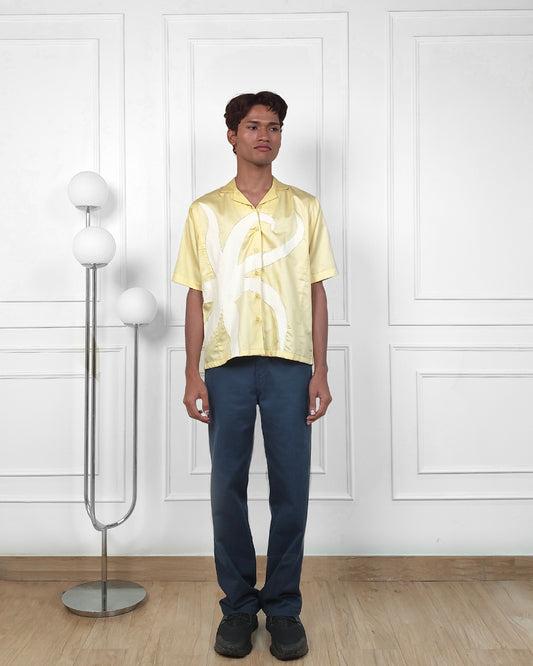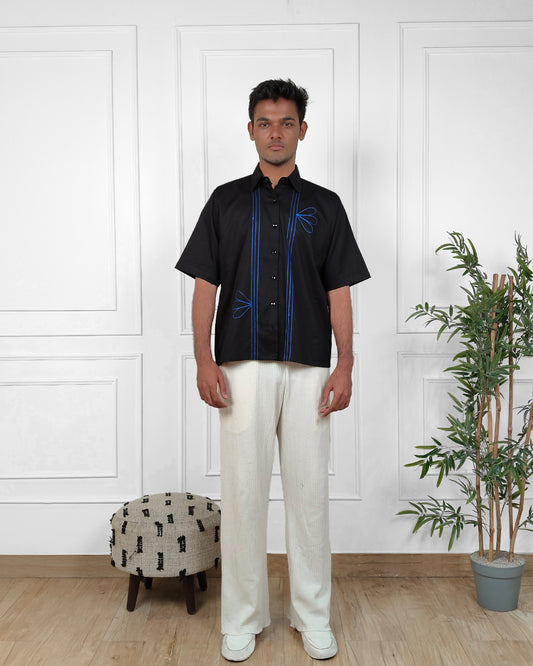
Why Sustainable Fashion Matters
What is Sustainable Fashion?
Sustainable fashion encompasses a range of practices and techniques aimed at minimizing the environmental and social impacts of clothing production and consumption all around the world. This includes:
- Eco-friendly materials: Using organic cotton, recycled fibers, and sustainable fabrics.
- Ethical labor practices: Ensuring fair wages and safe working conditions for garment workers involved throughout the production process from farmers, to weavers, to dyers, to tailors, to sales executives
- Circular economy: Promoting recycling, upcycling, and reducing waste. Supporting zero waste brands
The Environmental Impact of Fashion
The fashion industry is responsible for a staggering amount of pollution and waste. In 2024, the Global Fashion Agenda reported that:
- 10% of global carbon emissions come from the fashion industry, surpassing both international flights and maritime shipping.
- The industry contributes to 20% of global wastewater due to toxic chemicals from dyes and finishes, significantly harming ecosystems and communities reliant on clean water.
- Countries like Bangladesh and Vietnam, which are major garment producers, are facing severe pollution challenges due to lax regulations and fast fashion practices of brands like Zara, H&M, Temu, Fashion Nova, Topshop, and Shein
The Social Cost of Fast Fashion
Fast fashion thrives on cheap labor and exploitative practices. In 2024:
- Oxfam reported that garment workers in countries like Cambodia and Myanmar earn less than $3 a day, making it nearly impossible to meet basic living standards.
- The International Labor Organization states that over 60% of garment workers worldwide are women, often subjected to unsafe working conditions and limited rights.
The Pre-Consumer Waste Problem in Fashion
Pre-consumer waste refers to materials discarded during the manufacturing process before they reach consumers. This type of waste is a significant concern in the fashion industry, contributing to environmental degradation.
Fabric Waste: It is estimated that up to 30% of fabric is wasted during production. This accounts for around 92 million tons of waste annually in the global fashion industry (McKinsey & Company, 2024).
Cutting Room Waste: The cutting process in garment production generates around 20% of the fabric used, leading to billions of tons of textile waste every year (Ellen MacArthur Foundation, 2024).
Global Textile Waste: In 2024, the fashion industry is projected to generate 92 million tons of textile waste, including both pre-consumer and post-consumer waste (World Economic Forum, 2024).
Landfill Contribution: Approximately 87% of pre-consumer textile waste ends up in landfills, where it can take hundreds of years to decompose (U.S. Environmental Protection Agency, 2024).
Waste from Sampling: Brands can produce up to 10% of total fabric used in samples and prototypes, which are often discarded without being utilized (The Business of Fashion, 2024).
Cost of Waste: The economic impact of pre-consumer textile waste is estimated at $100 billion annually, reflecting lost opportunities and material costs (Global Fashion Agenda, 2024).
Environmental Impact: The production and disposal of pre-consumer waste contribute to 1.2 billion tons of greenhouse gas emissions annually (UN Environment Programme, 2024).
Industry Response: Over 60% of fashion brands have started implementing measures to reduce pre-consumer waste, showing a growing awareness of the issue (Fashion Revolution, 2024).
Brands like ODITE are making a conscious effort by innovating design and respecting South Asian heritage and creating zero waste
The Rise of Conscious Consumerism
As awareness grows, consumers are increasingly leaning towards sustainable fashion. A 2024 survey from the British Fashion Council found that:
- 71% of UK consumers believe sustainable fashion is essential for the future.
- 68% of Australians now consider sustainability a key factor when making fashion purchases.
This shift is crucial, as consumer behavior directly impacts brands’ decisions regarding production practices.
Statistics That Demand Attention
Global Insights
- The Ellen MacArthur Foundation warns that by 2030, the fashion industry could consume over 100 million tons of fiber annually, leading to increased pollution and resource depletion.
- In the US, approximately 85% of textiles end up in landfills each year, equating to 16 million tons of textile waste.
- The average American consumes about 70 garments annually, contributing to significant waste and environmental strain.
- Only 37% of consumers in the UK reported actively purchasing sustainable items, indicating a gap between awareness and action.
- Australia: The fashion industry is responsible for over 1.1 million tons of textile waste annually, with a growing interest in sustainability among consumers.
The Circular Fashion Movement
Circular fashion is gaining momentum as brands and consumers alike embrace more sustainable practices:
- Clothing rental services and second-hand marketplaces are projected to reach $64 billion by 2024 in the US alone, reflecting a significant shift towards sustainable consumption.
- Brands that adopt a circular model focus on reusing and recycling materials, effectively closing the loop on production and minimizing waste.
- Brands that create zero waste designs.
The Benefits of Sustainable Fashion
- Environmental Protection: Reducing pollution and resource consumption preserves ecosystems and biodiversity.
- Social Responsibility: Ethical practices ensure fair wages and safe working conditions, empowering communities.
- Economic Sustainability: Sustainable brands often support local artisans and economies, creating a positive economic impact.
Social Media as a Tool for Change
Social media platforms have become powerful vehicles for promoting sustainable fashion. In 2024:
- 80% of Gen Z consumers prefer brands that actively promote sustainability.
- Influencers and activists use their platforms to educate followers about the impacts of fast fashion, driving meaningful conversations around ethical consumption.
Government and Industry Response
Governments and organizations are recognizing the urgent need for sustainable practices in fashion:
- In the UK, the government has introduced initiatives to tackle fashion waste, including funding for recycling programs and support for sustainable start-ups.
- Australia has seen the launch of a national strategy aimed at reducing textile waste and promoting sustainable fashion practices.
Conclusion
The importance of sustainable fashion extends far beyond aesthetic appeal; it encompasses the well-being of our planet and its people. As consumers, we have the power to influence the fashion landscape by making informed choices. Each purchase is a vote for the kind of world we want to create—one that prioritizes sustainability, ethical labor practices, and environmental stewardship.
How You Can Contribute
- Educate Yourself: Stay informed about the practices of the brands you support. Learn about issues that can be solved by you, if you shop from zero waste brands.
- Choose Wisely: Opt for sustainable brands, second-hand items, or rentals when possible.
- Advocate: Use your voice on social media to raise awareness about the importance of sustainable fashion. Share information to get the word around.
- Reduce, Reuse, Recycle: Practice mindful consumption by reducing waste and recycling your old clothes.
By prioritizing sustainable fashion, we not only safeguard our environment but also support communities and foster a more equitable future. The time for change is now; let’s embrace sustainable fashion and pave the way for a brighter tomorrow.
- Global Fashion Agenda. (2024). Fashion on Climate: How the Fashion Industry Can Deliver a 1.5°C Future. [online] Available at: https://globalfashionagenda.com/publications/fashion-on-climate/ [Accessed 10 Oct. 2024].
- Ellen MacArthur Foundation. (2024). A New Textiles Economy: Redesigning Fashion's Future. [online] Available at: https://www.ellenmacarthurfoundation.org/assets/downloads/publications/A-New-Textiles-Economy_Full-Report_2017.pdf [Accessed 10 Oct. 2024].
- U.S. Environmental Protection Agency (EPA). (2024). Advancing Sustainable Materials Management: 2024 Fact Sheet. [online] Available at: https://www.epa.gov/sustainable-materials-management/advancing-sustainable-materials-management-2024-fact-sheet [Accessed 10 Oct. 2024].
- British Fashion Council. (2024). The State of UK Fashion: Consumer Research Findings. [online] Available at: https://www.britishfashioncouncil.com/research [Accessed 10 Oct. 2024].
- Oxfam. (2024). Fashion’s New Normal: The Impact of COVID-19 on the Global Garment Industry. [online] Available at: https://oxfamapps.org/fashion-new-normal-report-2024 [Accessed 11 Oct. 2024].
- International Labour Organization (ILO). (2024). World Employment and Social Outlook 2024: Trends 2024. [online] Available at: https://www.ilo.org/global/research/global-reports/weso/2024/lang--en/index.htm [Accessed 11 Oct. 2024].
- Australian Fashion Council. (2024). Australian Fashion Sustainability Report 2024. [online] Available at: https://www.australianfashioncouncil.com/sustainability-report [Accessed 11 Oct. 2024].
- McKinsey & Company. (2024). The State of Fashion 2024: The Global Fashion Industry. [online] Available at: https://www.mckinsey.com/industries/retail/our-insights/state-of-fashion-2024 [Accessed 11 Oct. 2024].
- The Business of Fashion. (2024). Resale Market to Reach $64 Billion by 2024: The Impact of Circular Fashion. [online] Available at: https://www.businessoffashion.com/articles/news/resale-market-report-2024 [Accessed 11 Oct. 2024].
- The Fashion Industry Charter for Climate Action. (2024). Annual Progress Report. [online] Available at: https://www.unfashioncharter.com/reports [Accessed 11 Oct. 2024].
- McKinsey & Company. (2024). The State of Fashion 2024: The Global Fashion Industry. [online] Available at: https://www.mckinsey.com/industries/retail/our-insights/state-of-fashion-2024 [Accessed 11 Oct. 2024].
- Ellen MacArthur Foundation. (2024). A New Textiles Economy: Redesigning Fashion's Future. [online] Available at: https://www.ellenmacarthurfoundation.org/assets/downloads/publications/A-New-Textiles-Economy_Full-Report_2017.pdf [Accessed 13 Oct. 2024].
- World Economic Forum. (2024). Fashion’s Future: The Circular Economy. [online] Available at: https://www.weforum.org/reports/fashion-s-future-the-circular-economy [Accessed 13 Oct. 2024].
- U.S. Environmental Protection Agency (EPA). (2024). Advancing Sustainable Materials Management: 2024 Fact Sheet. [online] Available at: https://www.epa.gov/sustainable-materials-management/advancing-sustainable-materials-management-2024-fact-sheet [Accessed 13 Oct. 2024].
- The Business of Fashion. (2024). State of Fashion 2024: The Global Fashion Industry. [online] Available at: https://www.businessoffashion.com/articles/news/state-of-fashion-2024 [Accessed 14 Oct. 2024].
- Textile Exchange. (2024). The Textile Sustainability Report 2024. [online] Available at: https://textileexchange.org/publications/reports/ [Accessed 14 Oct. 2024].
- Global Fashion Agenda. (2024). Fashion on Climate: How the Fashion Industry Can Deliver a 1.5°C Future. [online] Available at: https://globalfashionagenda.com/publications/fashion-on-climate/ [Accessed 14 Oct. 2024].
- UN Environment Programme. (2024). The Environmental Impact of Fashion Industry. [online] Available at: https://www.unep.org/resources/report/environmental-impact-fashion-industry [Accessed 18 Oct. 2024].
- Fashion Revolution. (2024). Fashion Transparency Index 2024. [online] Available at: https://www.fashionrevolution.org/about/transparency/ [Accessed 18 Oct. 2024].
- Image credit - https://www.pexels.com/photo/bird-s-eye-view-of-landfill-3181031/








